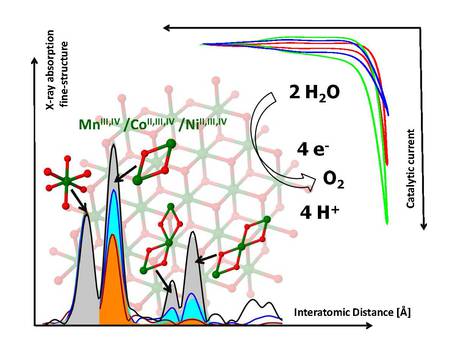Bioinspired and artificial metal oxides for water oxidation
Uncovering the mechanism of dioxygen formation in catalytic water oxidation is a highly topical research field in chemical and biological catalysis. Complementary to the studies in project E3-3, bioinspired functional metal oxides will be synthesized that catalyse water oxidation. Amorphous and highly hydrated metal oxides represent a class of quasi-heterogeneous catalysts with interesting properties, including redox and water-oxidation activity of the bulk material. In this respect, water-oxidising manganese oxides were identified as a prime research target, as they resemble the Mn(III/IV)4Ca(µ-O)n core of the biologically catalyst structurally and functionally.
Furthermore, after deposition on electrode surfaces, the redox-chemistry can be tracked by a combination of advanced spectroscopy with electrochemistry employing new in-situ experiments [time-resolved XAS and RR]. However, progress toward a complete mechanistic understanding of water oxidation in the biomimetic oxides is hampered by amorphicity at the atomic level. Therefore new ways toward better control of structure and elemental composition as well as comparative studies on structurally fully characterized molecular catalysts are pursued in D3-3.
The described experimental programme of UniCat researchers and their national and international co-workers addresses water oxidation by homogenous, heterogeneous and biological catalysts. By comparative mechanistic investigations on selected metal oxides (D3-3), molecular catalysts (D3-3), and the biological Mn4Ca complex (E3-3), identification of common principles and development of unifying concepts towards efficient catalysis of water oxidation is approached uniquely.
Research goals
- Molecular single-source precursors will be applied which enable the low temperature synthesis of desired metastable metal oxides in different morphologies and environments (colloids, amorphous powders, thin films), inaccessible by classical solid state synthesis. Elucidation of their composition-structure-activity relationships is intimately interconnected with various state-of-the-art spectroscopic methods and electrocatalysis.
- Electrocatalysis can mimic biological water splitting, however, it is also relevant for non-biological and more technological regimes. Therefore, a wide range of bulk and surface-sensitive spectroscopic, scattering, and voltammetric techniques, in-situ mechanistic studies of the electrocatalytic water oxidation process of bioinspired metal oxides will be performed to obtain detailed information on the kinetics of the elementary reactions, the nature of the reactive intermediates and the state of the reacting catalytic surface.
- Water oxidation in homogeneous catalysis is investigated by a thorough spectroscopic characterization of the catalytic cycle using X-ray absorption spectroscopy (XAS) and RR spectroscopy.
- Furthermore heterogenisation of the respective homogeneous catalysts on innovative semiconducting host materials capable of water splitting using visible light

